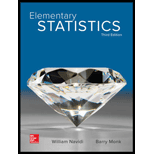
Elementary Statistics ( 3rd International Edition ) Isbn:9781260092561
3rd Edition
ISBN: 9781259969454
Author: William Navidi Prof.; Barry Monk Professor
Publisher: McGraw-Hill Education
expand_more
expand_more
format_list_bulleted
Concept explainers
Question
Chapter 14.2, Problem 26E
To determine
To find:The interaction plot and interpret the interaction plot.
Expert Solution & Answer
Want to see the full answer?
Check out a sample textbook solution
Students have asked these similar questions
Please could you explain why 0.5 was added to each upper limpit of the intervals.Thanks
28. (a) Under what conditions do we say that two random variables X and Y are
independent?
(b) Demonstrate that if X and Y are independent, then it follows that E(XY) =
E(X)E(Y);
(e) Show by a counter example that the converse of (ii) is not necessarily true.
1. Let X and Y be random variables and suppose that A = F. Prove that
Z XI(A)+YI(A) is a random variable.
Chapter 14 Solutions
Elementary Statistics ( 3rd International Edition ) Isbn:9781260092561
Ch. 14.1 - In Exercises 7 and 8, fill in each blank with the...Ch. 14.1 - Prob. 8ECh. 14.1 - Prob. 9ECh. 14.1 - Prob. 10ECh. 14.1 - Prob. 11ECh. 14.1 - Prob. 12ECh. 14.1 - In a one-way ANOVA, the following data were...Ch. 14.1 - In a one-way ANOVA, the following data were...Ch. 14.1 - Samples were drawn from three populations. The...Ch. 14.1 - Samples were drawn from three populations. The...
Ch. 14.1 - Pesticide danger: One of the factors that...Ch. 14.1 - Life-saving drug: Penicillin is produced by the...Ch. 14.1 - Pesticide danger: Using the data in Exercise 17,...Ch. 14.1 - Life-saving drug: Using the data in Exercise 18,...Ch. 14.1 - Artificial hips: Artificial hip joints consist of...Ch. 14.1 - Floods: Rapid drainage of floodwater is crucial to...Ch. 14.1 - Artificial hips: Using the data in Exercise 21,...Ch. 14.1 - Floods: Using the data in Exercise 22, perform the...Ch. 14.1 - Polluting power plants: Power plants can emit...Ch. 14.1 - Prob. 26ECh. 14.1 - Prob. 27ECh. 14.1 - Prob. 28ECh. 14.1 - Prob. 29ECh. 14.1 - Prob. 30ECh. 14.1 - Prob. 31ECh. 14.2 - Prob. 5ECh. 14.2 - Prob. 6ECh. 14.2 - Prob. 7ECh. 14.2 - Prob. 8ECh. 14.2 - In a two-way ANOVA, the P-value for interactions...Ch. 14.2 - Prob. 10ECh. 14.2 - Prob. 11ECh. 14.2 - Prob. 12ECh. 14.2 - Prob. 13ECh. 14.2 - Prob. 14ECh. 14.2 - Prob. 15ECh. 14.2 - Prob. 16ECh. 14.2 - Prob. 17ECh. 14.2 - Prob. 18ECh. 14.2 - Prob. 19ECh. 14.2 - Prob. 20ECh. 14.2 - Prob. 21ECh. 14.2 - Prob. 22ECh. 14.2 - Prob. 23ECh. 14.2 - Strong beams: The following table presents...Ch. 14.2 - Prob. 25ECh. 14.2 - Prob. 26ECh. 14.2 - Fruit yields: An agricultural scientist performed...Ch. 14.2 - Prob. 28ECh. 14.2 - Prob. 29ECh. 14 - Exercises 1-4 refer to the following data: At a...Ch. 14 - Prob. 2CQCh. 14 - Prob. 3CQCh. 14 - Prob. 4CQCh. 14 - Prob. 5CQCh. 14 - Prob. 6CQCh. 14 - Prob. 7CQCh. 14 - Prob. 8CQCh. 14 - Prob. 9CQCh. 14 - Prob. 10CQCh. 14 - Prob. 1RECh. 14 - Prob. 2RECh. 14 - Prob. 3RECh. 14 - Prob. 4RECh. 14 - Prob. 5RECh. 14 - Prob. 6RECh. 14 - Prob. 7RECh. 14 - Prob. 8RECh. 14 - Prob. 9RECh. 14 - Prob. 10RECh. 14 - Prob. 11RECh. 14 - Prob. 12RECh. 14 - Prob. 13RECh. 14 - Prob. 14RECh. 14 - Prob. 15RECh. 14 - Prob. 1WAICh. 14 - Prob. 2WAICh. 14 - Prob. 3WAICh. 14 - Prob. 4WAICh. 14 - Prob. 5WAICh. 14 - Prob. 1CSCh. 14 - Prob. 2CSCh. 14 - Prob. 3CSCh. 14 - Prob. 4CS
Knowledge Booster
Learn more about
Need a deep-dive on the concept behind this application? Look no further. Learn more about this topic, statistics and related others by exploring similar questions and additional content below.Similar questions
- (c) Utilize Fubini's Theorem to demonstrate that E(X)= = (1- F(x))dx.arrow_forward(c) Describe the positive and negative parts of a random variable. How is the integral defined for a general random variable using these components?arrow_forward26. (a) Provide an example where X, X but E(X,) does not converge to E(X).arrow_forward
- (b) Demonstrate that if X and Y are independent, then it follows that E(XY) E(X)E(Y);arrow_forward(d) Under what conditions do we say that a random variable X is integrable, specifically when (i) X is a non-negative random variable and (ii) when X is a general random variable?arrow_forward29. State the Borel-Cantelli Lemmas without proof. What is the primary distinction between Lemma 1 and Lemma 2?arrow_forward
arrow_back_ios
SEE MORE QUESTIONS
arrow_forward_ios
Recommended textbooks for you
 Big Ideas Math A Bridge To Success Algebra 1: Stu...AlgebraISBN:9781680331141Author:HOUGHTON MIFFLIN HARCOURTPublisher:Houghton Mifflin Harcourt
Big Ideas Math A Bridge To Success Algebra 1: Stu...AlgebraISBN:9781680331141Author:HOUGHTON MIFFLIN HARCOURTPublisher:Houghton Mifflin Harcourt Glencoe Algebra 1, Student Edition, 9780079039897...AlgebraISBN:9780079039897Author:CarterPublisher:McGraw Hill
Glencoe Algebra 1, Student Edition, 9780079039897...AlgebraISBN:9780079039897Author:CarterPublisher:McGraw Hill

Big Ideas Math A Bridge To Success Algebra 1: Stu...
Algebra
ISBN:9781680331141
Author:HOUGHTON MIFFLIN HARCOURT
Publisher:Houghton Mifflin Harcourt

Glencoe Algebra 1, Student Edition, 9780079039897...
Algebra
ISBN:9780079039897
Author:Carter
Publisher:McGraw Hill
Correlation Vs Regression: Difference Between them with definition & Comparison Chart; Author: Key Differences;https://www.youtube.com/watch?v=Ou2QGSJVd0U;License: Standard YouTube License, CC-BY
Correlation and Regression: Concepts with Illustrative examples; Author: LEARN & APPLY : Lean and Six Sigma;https://www.youtube.com/watch?v=xTpHD5WLuoA;License: Standard YouTube License, CC-BY